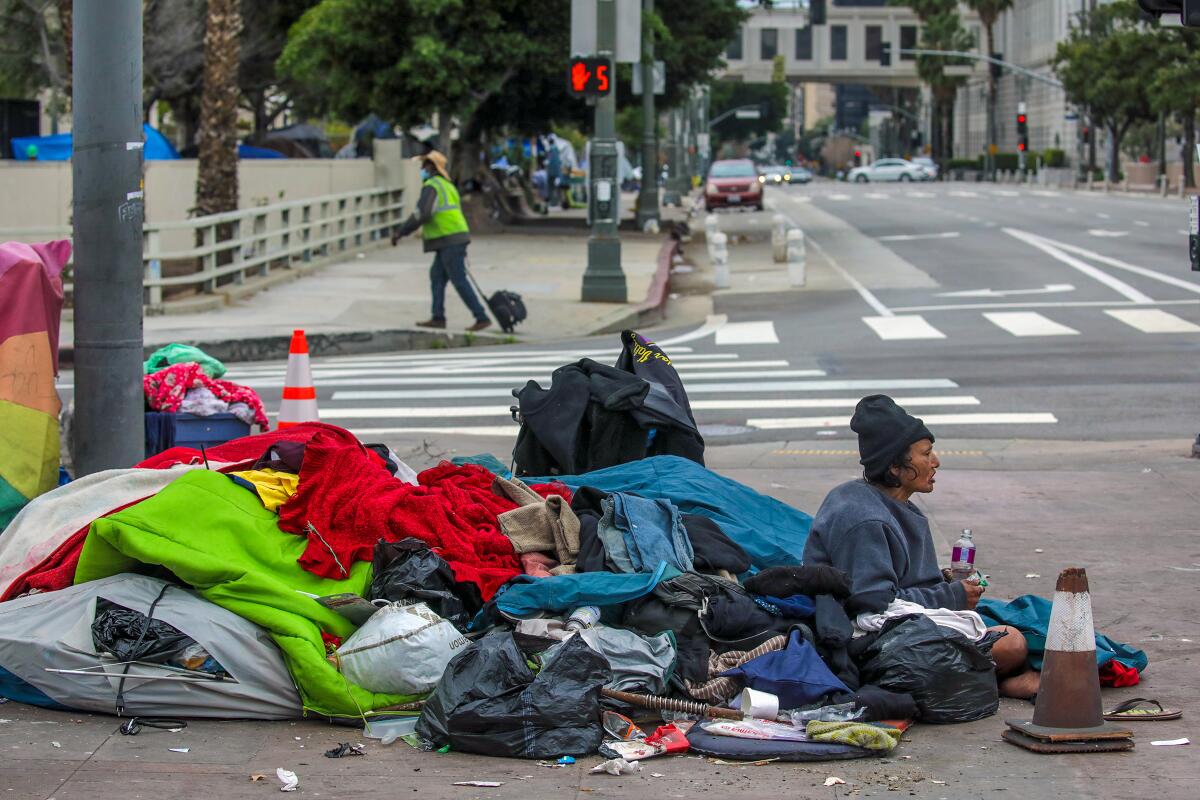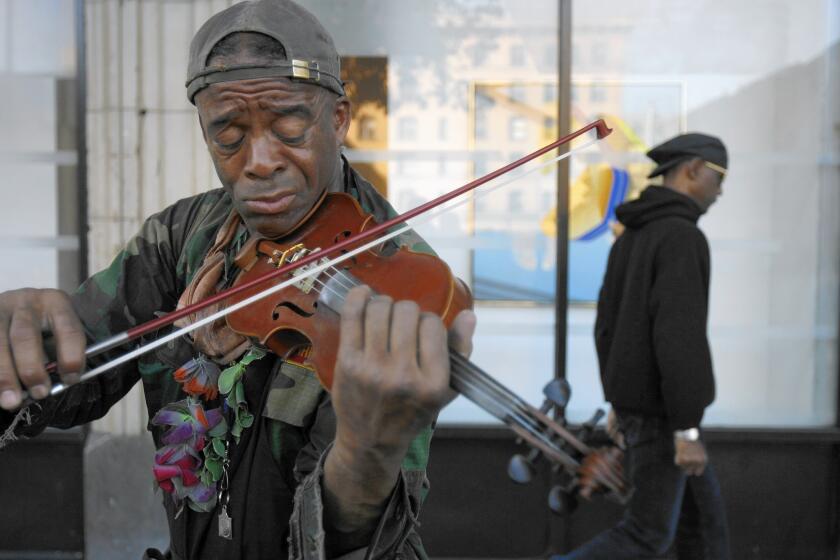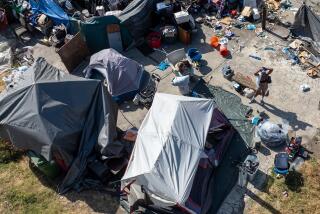Column: I’ve written about L.A.’s mental illness crisis for almost 20 years. We have to do better

- Share via
Seventeen years ago this month, I met a musician who slept on L.A.’s skid row and talked about trying to get back on track and join an orchestra. Like many homeless people, he fought a daily battle with mental illness that, for him, first surfaced 35 years earlier, when he was a student at Juilliard.
As I got to know Mr. Ayers, I was shocked by how many other castoffs were struggling to survive on the streets, suffering without hope. I began writing about this shameful American reality, thinking that shining a light might spark a collective response to what is, without question, a fixable tragedy.
But nearly two decades in, little has changed.
Estimates vary, but a Times analysis two years ago found that roughly half of L.A. County’s homeless people were dealing with a mental illness, and last June, about 40% of L.A. County jail inmates were diagnosed with a mental illness.
“The bottom line is that the mental health systems in this country, and this state and this county, are completely inadequate,” Dr. Jonathan Sherin, L.A. County’s director of mental health, told The Times last month in a brutally honest assessment. “We have what I call the open-air asylum of the street, and the closed-air asylum of the jail.”
So why does it have to be this way?
It doesn’t.
As we enter campaign season for local offices, including L.A. mayor, I wanted to focus on two drivers of homelessness — for this column, mental illness, and later on, addiction. I’m not saying those are the biggest factors, but without smarter responses, the tents will be a permanent part of the landscape.
When I reached out to experts in the mental health field to ask what went wrong and how to build a better system, I got equal doses of frustration and hope.
As for what went wrong, we can look to the forces of low wages, high housing costs, scaled back federal housing support, drug epidemics, the stigma around mental illness and the lack of parity with physical health services, insurance coverage and access to care. And then there’s the well-intended protection of civil liberties, which can make it legally difficult to help people who are dying on sidewalks and in tents.
I have been a transporter and caretaker of various musical instruments for nearly 13 years.
Another key is that mental hospitals were emptied decades ago without the promised network of community clinics. Former California Gov. and President Ronald Reagan often is deservedly assigned blame, but over the decades, Democratic governors and presidents have come and gone without making needed fixes.
“Other countries do so much better,” says Dr. Tom Insel, a psychiatrist and neuroscientist who was director of the National Institute of Mental Health for 13 years and has served as an advisor to Gov. Gavin Newsom. “Canada, Australia, Japan and European countries … are all making progress and we’re failing.”
In the U.S., Insel says, there’s been great scientific research into disorders such as schizophrenia, but it hasn’t translated into effective care. In a recent op-ed for the Atlantic, Insel called American mental health care “a disaster on many fronts,” and said “the U.S. does not currently have a system that can help Americans heal and recover.”
The measure of success shouldn’t be how many psychiatric beds we can fill, Insel told me, but how many we can empty.
And that brings me to Trieste, Italy, where I met Insel in 2019, when he was researching a book called “Healing: Our Path from Mental Illness to Mental Health.” Both of us were checking out the much-heralded mental health system in Trieste (a system that unfortunately is now threatened by rightist Italian leaders and those who want a more traditional model).
In Trieste — which admittedly has advantages over L.A., such as a much smaller population, no raging meth epidemic and no housing crisis — they’ve done things much differently for decades. People with mental illness are embraced rather than shunned, care is consistent and long-term, bureaucracy is virtually nonexistent, and clients help design their own return to meaningful pursuits, including jobs.
They help people with mental illness recover, in short, and that word is written boldly on Insel’s prescription for a better system. It’s a reference to what’s called the recovery model, and I was lucky 17 years ago to have been referred to the Village in downtown Long Beach, where I got to see what it looks like.
Dr. Mark Ragins, the medical director at the time, sat at a desk in what looked more like a drop-in center than a doctor’s office. A new client walked in wearing gym shorts, dark shades and a giant straw hat that was perched atop a red ball cap.
“Well,” Ragins said to the man, “how can we be of help to you?”
Ragins — whose book “Frontier: A Rebellious Guide to Psychosis and Other Extraordinary Experiences,” assails the U.S. mental health system and plots a smarter course — had a fairly normal conversation with the client. He later explained to me that rather than make a diagnosis and write a prescription on day one, he wanted to get to know the guy and begin building a relationship.
After that, he’d offer a full range of support and customized services fit to the individual’s needs, possibly including housing or a job, along with therapy and possibly medication. A key part of the strategy was to make the client feel — after years of isolation — like he had a place where he was welcome, could be productive, and was part of a community.
This, by the way, isn’t necessarily easy to do, depending on the severity of the disease and other factors. When I wrote that column, one psychiatrist scoffed, warning me that serious psychosis couldn’t be cured with coddling or a hug.
True enough, but recovery does not mean cure. It means carefully unraveling the many layers of terror, distrust and anger formed by years of haunting illness and the trauma of homelessness, and locating the human being still wrapped in all that pain.
That kind of engagement can take a long time and a lot of continuity, both of which are in short supply in our system. My friend Mr. Ayers was reluctant to return to the world that had exiled him — a world of harsh judgment, rules and pressure. It took a year for me and a team of professionals to earn his trust, and though he’s had a roof over his head ever since, recovery is not linear, and every day is a new trial.
What I saw at the Village, though, was hope. A lot of clients there eventually found new purpose, signing on as outreach workers and using their own experience to reel others in.
We need more of that. And some of this too:
In the early days of the Village, says former administrator Dave Pilon, the state paid the nonprofit $15,000 per client per year. No billing, no bureaucracy, no time wasted pushing paper rather than helping clients. When the state handed off to the county, the nightmares began, and Sherin, the county’s mental health chief, can tell you what that’s like.
“The money we get has so many … strings attached in terms of how it can be used and how it cannot be used, with reports that are exhausting and required documentation that ends up getting scrutinized and audited,” he told me.
Sherin said he’d prefer having county officials give him a specific set of desired outcomes, such as an annual percentage reduction in the number of homeless mentally ill people, along with a budget and enough discretion to make it happen.
“Hold us accountable for getting the outcomes … and if we can’t achieve them, then send me packing,” Sherin said. “But don’t constrain me. What’s happening is that the system is stealing the heart and soul of the people trying to do the work. … The administrative burden is outrageous and makes it impossible to focus on the mission.”
If we can identify all the impediments to good care, can’t we find the will to remove them and build a better system?
“I think we can,” said UCLA health policy research scientist Imelda Padilla-Frausto, a member of the L.A. County Mental Health Commission, who is big on homelessness prevention and early mental health intervention.
The county is housing thousands of people each year but the lifeboat is still taking on water. Padilla-Frausto calls for a greater “upstream approach” that targets social and economic needs early on, so that “we are not left bailing out a sinking boat.” She said there have to be more support services for people in their late teens and early 20s, which is when many serious mental illnesses first manifest.
It’s not as if there’s no success to build on.
Ragins applauded a county program my colleague Emily Alpert Reyes just wrote about, called Law Enforcement Assisted Diversion, in which outreach workers visit homeless clients who’ve committed minor offenses and try to help them find their footing before they stumble again.
Mental Health Court Judge Jim Bianco told me mentally ill defendants in county jail have to wait six to nine months for a spot in a psychiatric hospital, but he applauded the successes of the county’s Diversion and Reentry housing program, which is helping keep released inmates from returning.
Insel told me he has great hope for CalAIM, a new state program designed to cut through the bureaucracy and deliver more consistent, long-term physical and mental health care.
Sherin said he hasn’t given up on starting a pilot of the Trieste model in Hollywood, though it’s been hung up by bureaucracy.
“I don’t think we need to start from scratch,” said Amie Quigley, director of urban mission and community outreach at Hollywood First Presbyterian Church, where homeless people helped construct the drop-in center. (That satisfies Sherin’s “3 Ps” philosophy, which is to connect with people, give them a place, and give them purpose.)
We now have a full field of candidates for Los Angeles mayor. Can any of them solve the homelessness crisis?
When I went to visit Quigley a few days ago, I came upon a dazed, sun-blistered, nearly naked man outside the church. He appeared to be relatively young, but illness and exposure had aged him. Just one more of the sad, broken, nomadic figures we’re all accustomed to seeing. Quigley got some clothes for the guy, who said he wanted to go home to Florida. Quigley called his mother and began making arrangements to get him reunited with his family.
Quigley told me something I’ve heard often in the last 17 years. It’s not that we don’t know what works, it’s that we don’t have enough of it, and we need to be better organized, focused and individualized.
Quigley suggested dividing L.A. into catchment areas. Establish a zone, identify a goal such as housing 1,000 people with a mental illness, then put teams from various agencies to work under one authority in this one location, with funding and community involvement.
“We have to put up some boundaries too, and say you can’t have tents up all day,” Quigley said.
She thinks tents send the wrong message, in many ways, about what’s acceptable, and can be a hindrance to needed care as well as a cover for drug use at a time when fentanyl-laced meth is killing people. Offer safe housing and meeting places as alternatives to tents, she said, and restore civility in the most humane way possible.
Getting back to Mr. Ayers, our weekly visits have been limited during the pandemic, but we do still get together when possible and chat regularly by phone. His current inspiration is the Tchaikovsky violin concerto.
Mr. Ayers is a constant reminder to me that what exists on our streets and in our jails is morally unacceptable, and difficult but possible to address. One of his case managers was the late great Mollie Lowery, co-founder of LAMP Community in the 1980s and a tireless advocate. Lowery had a motto she imparted to me and to her many trainees enlisted to help those suffering with mental illness.
Do whatever it takes, for as long as it takes.
And nothing less.
More to Read
Sign up for Essential California
The most important California stories and recommendations in your inbox every morning.
You may occasionally receive promotional content from the Los Angeles Times.













